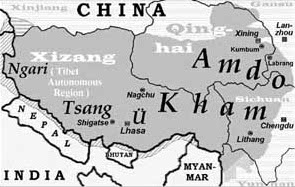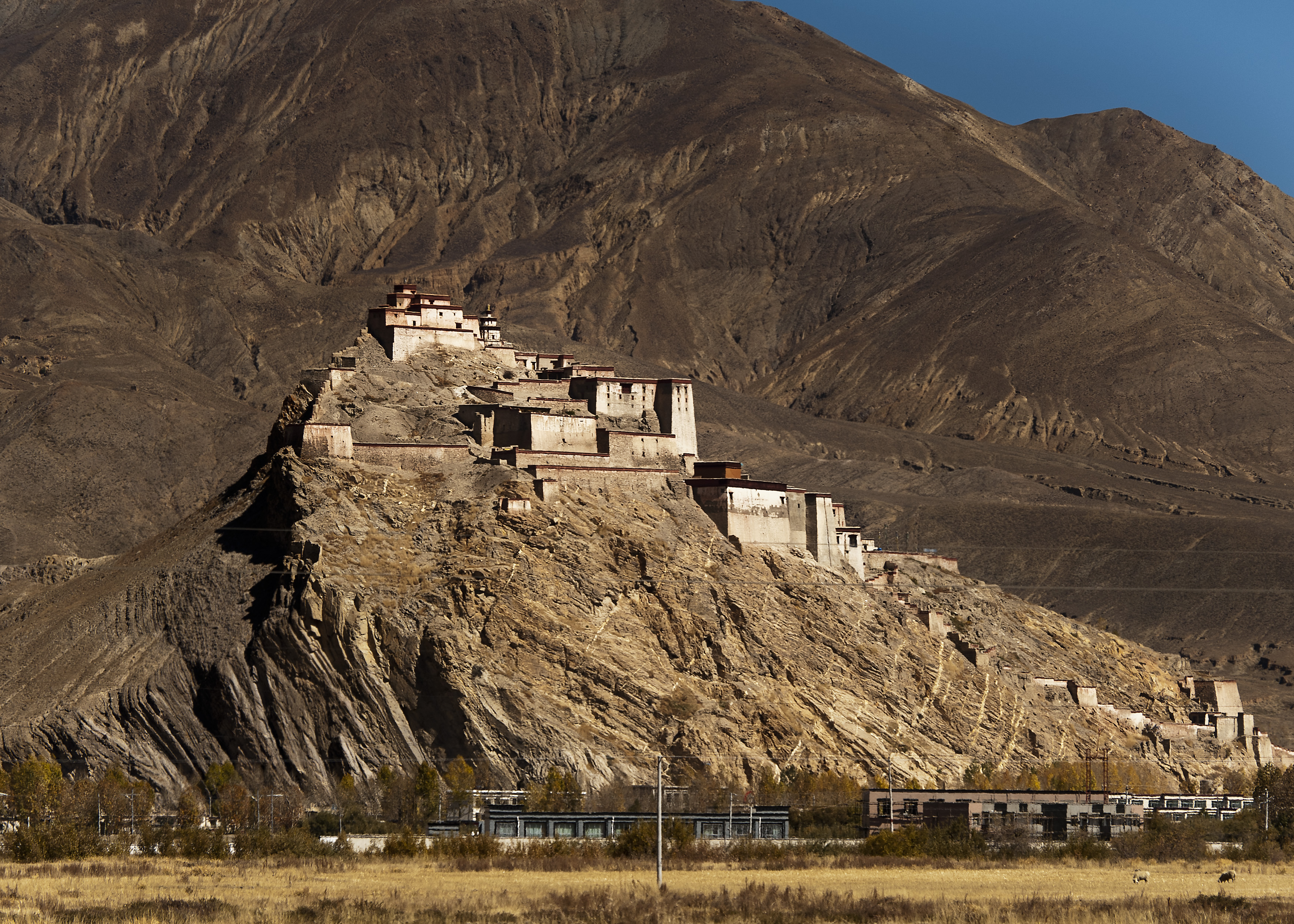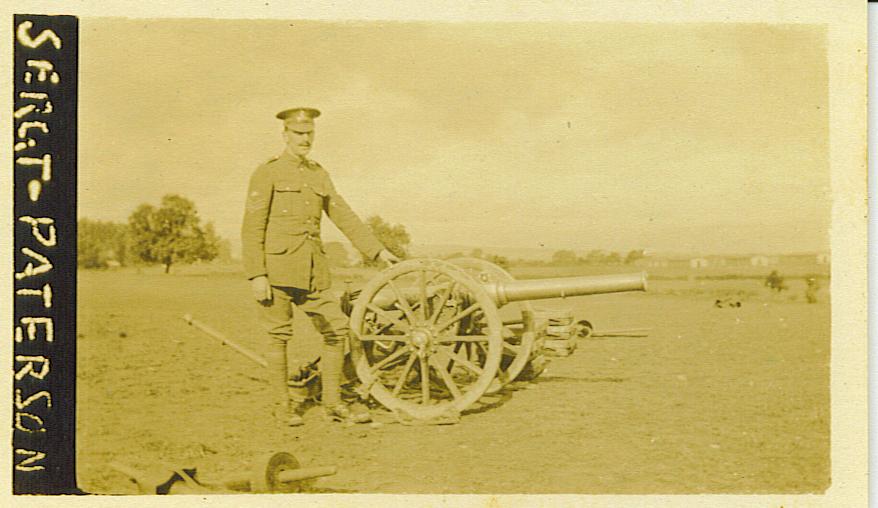|
Tsechen Monastery And Dzong
Tsechen Monastery (also known as the Tsechen Dzong or the Shambu Tsegu) was a Tibetan monastery located approximately northwest of Gyantse. It was one of the largest of the fortified monasteries constructed in Tibet, and was located above a village also known as Tsechen. Constructed "on another precipitous hill about 600 feet high, about one mile long, and rising abruptly out of the plain", the monastery was similar to the Gyantse Dzong in terms of the strength of its fortifications. During the 1904 British expedition to Tibet by Colonel Francis Younghusband, the monastery was occupied by Tibetan troops, which used it to resist the expedition's advance. Younghusband's forces captured the monastery and sacked and burnt it; some of the hilltop walls are all that remain of the structure. Early history It was founded by Nyawon Kunga Pel (1285 - 1379) in 1366, under the sponsorship of Prince Phakpa Pelzangpo (1318-1370 CE), Gyantse's first prince. Nyawon Kunga Pel gave teaching ... [...More Info...] [...Related Items...] OR: [Wikipedia] [Google] [Baidu] |
Ü-Tsang
Ü-Tsang is one of the three traditional provinces of Tibet, the others being Amdo in the north-east, and Kham in the east. Ngari (including former Guge kingdom) in the north-west was incorporated into Ü-Tsang. Geographically Ü-Tsang covered the south-central of the Tibetan cultural area, including the Brahmaputra River watershed. The western districts surrounding and extending past Mount Kailash are included in Ngari, and much of the vast Changtang plateau to the north. The Himalayas defined Ü-Tsang's southern border. The present Tibet Autonomous Region corresponds approximately to what was ancient Ü-Tsang and western Kham. Ü-Tsang was formed by the merging of two earlier power centers: Ü () in central Tibet, controlled by the Gelug lineage of Tibetan Buddhism under the early Dalai Lamas, and Tsang () which extended from Gyantse to points west, controlled by the rival Sakya lineage. Military victories by the powerful Khoshut Mongol Güshi Khan that backed 5th Dalai ... [...More Info...] [...Related Items...] OR: [Wikipedia] [Google] [Baidu] |
James Macdonald (British Army Officer)
Major General Sir James Ronald Leslie Macdonald (8 February 1862 – 27 June 1927) was a British engineer, explorer, military officer and cartographer. Born in the Madras Presidency, he was a balloon observer as a young man, surveyed for railways in British India and East Africa, explored the upper Nile region, commanded balloon sections during the Second Boer War and Boxer Rebellion and led the British expedition to Tibet in 1903–1904. Early career Macdonald was born on 8 February 1862 in Rajahmundry in the Madras Presidency, India, the son of Surgeon-Major James Macdonald (1828–1906) of Aberdeen and Margaret Helen Leslie ''née'' Collie (1841-1876); his younger sister was the Egyptologist and archaeologist Nora Griffith. He was educated at Aberdeen Grammar School and the University of Aberdeen. He passed through the Royal Military Academy and was gazetted to the Royal Engineers in 1882. As a lieutenant, on 15 May 1885 Macdonald was appointed to the corps of Bengal Sappe ... [...More Info...] [...Related Items...] OR: [Wikipedia] [Google] [Baidu] |
Buddhist Temples In Tibet
Buddhism ( , ), also known as Buddha Dharma and Dharmavinaya (), is an Indian religion or philosophical tradition based on teachings attributed to the Buddha. It originated in northern India as a -movement in the 5th century BCE, and gradually spread throughout much of Asia via the Silk Road. It is the world's fourth-largest religion, with over 520 million followers (Buddhists) who comprise seven percent of the global population. The Buddha taught the Middle Way, a path of spiritual development that avoids both extreme asceticism and hedonism. It aims at liberation from clinging and craving to things which are impermanent (), incapable of satisfying ('), and without a lasting essence (), ending the cycle of death and rebirth (). A summary of this path is expressed in the Noble Eightfold Path, a training of the mind with observance of Buddhist ethics and meditation. Other widely observed practices include: monasticism; "taking refuge" in the Buddha, the , and the ... [...More Info...] [...Related Items...] OR: [Wikipedia] [Google] [Baidu] |
Dzongs In Tibet
Dzong architecture is used for dzongs, a distinctive type of fortified monastery ( dz, རྫོང, , ) architecture found mainly in Bhutan and Tibet. The architecture is massive in style with towering exterior walls surrounding a complex of courtyards, temples, administrative offices, and monks' accommodation. Characteristics Distinctive features include: * High inward sloping walls of brick and stone painted white with few or no windows in the lower sections of the wall * Use of a surrounding red ochre stripe near the top of the walls, sometimes punctuated by large gold circles * Use of unique style flared roofs atop interior temples * Massive entry doors made of wood and iron * Interior courtyards and temples brightly colored in Buddhist-themed art motifs such as the ashtamangala or swastika Regional differences Bhutan Dzongs serve as the religious, military, administrative, and social centers of their district. They are often the site of an annual ''tsechu'' or religiou ... [...More Info...] [...Related Items...] OR: [Wikipedia] [Google] [Baidu] |
Forts In Tibet
A fortification is a military construction or building designed for the defense of territories in warfare, and is also used to establish rule in a region during peacetime. The term is derived from Latin ''fortis'' ("strong") and ''facere'' ("to make"). From very early history to modern times, defensive walls have often been necessary for cities to survive in an ever-changing world of invasion and conquest. Some settlements in the Indus Valley civilization were the first small cities to be fortified. In ancient Greece, large stone walls had been built in Mycenaean Greece, such as the ancient site of Mycenae (famous for the huge stone blocks of its 'cyclopean' walls). A Greek '' phrourion'' was a fortified collection of buildings used as a military garrison, and is the equivalent of the Roman castellum or English fortress. These constructions mainly served the purpose of a watch tower, to guard certain roads, passes, and borders. Though smaller than a real fortress, they acted ... [...More Info...] [...Related Items...] OR: [Wikipedia] [Google] [Baidu] |
Charles Allen (writer)
Charles Robin Allen (2 January 1940 – 16 August 2020) was a British freelance writer and popular historian from London. His British parents were both born in India and his numerous works focus on the British Raj. Biography Charles Allen was born in Kanpur, India, where six generations of his family served under the British Raj. His father was a political officer on the North East Frontier. When Allen was four years old his father, Geoffrey St G.T. Allen was appointed Assistant Political Officer on the Balipara Frontier Tract in Assam, India. For several years the family lived at Sadiay, on the banks of the Brahmaputra River. It was here that Allen met the various tribesmen, mostly Abor and Mishmi warriors, that came down from the hills. Later when Allen had returned to England he heard about the exploits of his great grandfather, Colonel St G. C. Gore, Surveyor-General of India from 1899 to 1904, who had spent a lot of time in the Himalayas. Allen also met Colonel Kenneth Ma ... [...More Info...] [...Related Items...] OR: [Wikipedia] [Google] [Baidu] |
BL 10-pounder Mountain Gun
The Ordnance BL 10 pounder mountain gun was developed as a BL successor to the RML 2.5 inch screw gun which was outclassed in the Second Boer War. History This breech-loading gun was an improvement on the muzzle-loading screw gun but still lacked any recoil absorber or recuperator mechanism. It could be dismantled into 4 loads of approximately for transport, typically by mule. It was originally manufactured without a Gun shield, but these were made and fitted locally during World War I e.g. at Nairobi in 1914 for the East Africa campaign, also at Suez in 1915 for the Gallipoli campaign. It was eventually replaced by the BL 2.75 inch Mountain Gun from 1914 onwards but was still the main mountain gun in service when World War I began. Combat service British mountain guns were operated by men of the Royal Garrison Artillery. World War I Guns of the 26th Mountain Battery of the Indian Army were the first British Empire artillery to open fire in the Middle East in World W ... [...More Info...] [...Related Items...] OR: [Wikipedia] [Google] [Baidu] |
Shigatse
Shigatse, officially known as Xigazê (; Nepali: ''सिगात्से''), is a prefecture-level city of the Tibet Autonomous Region of the People's Republic of China. Its area of jurisdiction, with an area of , corresponds to the historical Tsang region of Tibet. Overview The administrative center of the prefecture-level city is the Samzhubzê District. It is roughly equivalent to the historical Shigatse urban center, the second-largest city in Tibet, located about southwest of Lhasa and home to the Tashilhunpo Monastery, traditionally the seat of the Panchen Lama. Some of the towns in the prefecture are: Gyantse (Gyantse County), Tingri (Tingri County), and Nyalam (Nyalam County). On 11 July 2014 Shigatse Prefecture was upgraded into a prefecture-level city (the same status as Lhasa). Transport Rail The Lhasa–Xigazê Railway connects Xigazê Railway Station with Lhasa and further connects with Qinghai via Qinghai–Tibet Railway. It takes about 3 hours t ... [...More Info...] [...Related Items...] OR: [Wikipedia] [Google] [Baidu] |
Lhasa
Lhasa (; Lhasa dialect: ; bo, text=ལྷ་ས, translation=Place of Gods) is the urban center of the prefecture-level city, prefecture-level Lhasa (prefecture-level city), Lhasa City and the administrative capital of Tibet Autonomous Region in Southwest China. The inner urban area of Lhasa City is equivalent to the administrative borders of Chengguan District (), which is part of the wider prefectural Lhasa City. Lhasa is the second most populous urban area on the Tibetan Plateau after Xining and, at an altitude of , Lhasa is one of the List of highest large cities, highest cities in the world. The city has been the religious and administrative capital of Tibet since the mid-17th century. It contains many culturally significant Tibetan Buddhism, Tibetan Buddhist sites such as the Potala Palace, Jokhang Temple and Norbulingka Palaces. Toponymy Lhasa literally translates to "place of gods" ( , god; , place) in the Standard Tibetan, Tibetan language. Chengguan literally tra ... [...More Info...] [...Related Items...] OR: [Wikipedia] [Google] [Baidu] |
Jokhang
The Jokhang (, ), also known as the Qoikang Monastery, Jokang, Jokhang Temple, Jokhang Monastery and Zuglagkang ( or Tsuklakang), is a Buddhist temple in Barkhor Square in Lhasa, the capital city of Tibet Autonomous Region of China. Tibetans, in general, consider this temple as the most sacred and important temple in Tibet. The temple is currently maintained by the Gelug school, but they accept worshipers from all sects of Buddhism. The temple's architectural style is a mixture of Indian vihara design, Tibetan and Nepalese design. The Jokhang was founded during King Songtsen Gampo's reign of the Tibetan Empire. According to tradition, the temple was built for the king's two brides: Princess Wencheng of the Chinese Tang dynasty and Princess Bhrikuti of Nepal. Both are said to have brought important Buddhist statues and images from China and Nepal to Tibet, which were housed here, as part of their dowries. The oldest part of the temple was built in 652. Over the next 900 years, th ... [...More Info...] [...Related Items...] OR: [Wikipedia] [Google] [Baidu] |
Tibet
Tibet (; ''Böd''; ) is a region in East Asia, covering much of the Tibetan Plateau and spanning about . It is the traditional homeland of the Tibetan people. Also resident on the plateau are some other ethnic groups such as Monpa people, Monpa, Tamang people, Tamang, Qiang people, Qiang, Sherpa people, Sherpa and Lhoba peoples and now also considerable numbers of Han Chinese and Hui people, Hui settlers. Since Annexation of Tibet by the People's Republic of China, 1951, the entire plateau has been under the administration of the People's Republic of China, a major portion in the Tibet Autonomous Region, and other portions in the Qinghai and Sichuan provinces. Tibet is the highest region on Earth, with an average elevation of . Located in the Himalayas, the highest elevation in Tibet is Mount Everest, Earth's highest mountain, rising 8,848.86 m (29,032 ft) above sea level. The Tibetan Empire emerged in the 7th century. At its height in the 9th century, the Tibet ... [...More Info...] [...Related Items...] OR: [Wikipedia] [Google] [Baidu] |
Tsongkapa
Tsongkhapa ('','' meaning: "the man from Tsongkha" or "the Man from Onion Valley", c. 1357–1419) was an influential Tibetan Buddhist monk, philosopher and tantric yogi, whose activities led to the formation of the Gelug school of Tibetan Buddhism.Tsong khapa (2006), pp. ix-x. He is also known by his ordained name Losang Drakpa (, Skt. Sumatikīrti) or simply as "Je Rinpoche" (, "Precious Lord"). He is also known by Chinese as Zongkapa Lobsang Zhaba or just Zōngkàbā (宗喀巴). Tsongkhapa was born in Amdo, the son of a Tibetan Longben Tribal leader who also once served as an official of the Yuan Dynasty. As a monk, he studied under numerous teachers of the various Tibetan Buddhist traditions which flourished in central Tibet, including Sakya, Jonang, Kagyu and Kadam. Tsongkhapa was a prolific author with a broad knowledge of Buddhist philosophy, logic, hermeneutics and practice. He wrote numerous works on madhyamaka philosophy (such as ''Ocean of Reasoning,'' a comme ... [...More Info...] [...Related Items...] OR: [Wikipedia] [Google] [Baidu] |








.jpg)